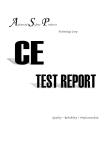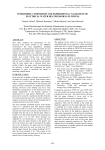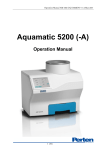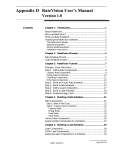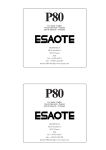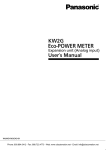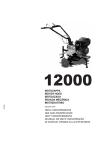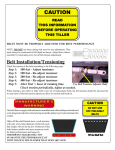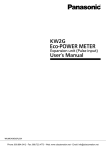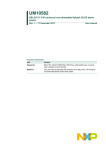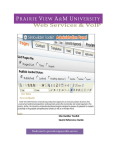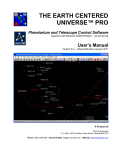Download User Manual
Transcript
Online Decision Tool for Anaerobic Digestion at Colorado Cattle Operations: User Manual December, 2011 Sybil Sharvelle Colorado State University Catherine Keske Colorado State University Jessica Davis Colorado State University Jeff Lasker Colorado State University Online Decision Tool for Anaerobic Digestion at Colorado Cattle Operations: User Manual Table of Contents 1. 2. Introduction .......................................................................................................................................... 3 1.1 Background .................................................................................................................................. 3 1.2 Constraints of Tool ........................................................................................................................ 3 Getting Started...................................................................................................................................... 4 2.1 Web Site Address for Tool ............................................................................................................ 4 2.2 Java Enabled.................................................................................................................................. 4 2.3 Website Layout ............................................................................................................................. 4 2.4 Input Values .................................................................................................................................. 5 3. Statement of Confidentiality ................................................................................................................. 5 4. AD Feasibility Tool Guide ...................................................................................................................... 6 5. 4.1 Preliminary Feasibility Questions .................................................................................................. 6 4.2 Determining the Most Appropriate Technology ........................................................................... 7 4.3 More Detailed Feasibility Analysis ............................................................................................... 10 4.5 Estimating Methane Generation Potential and Water Requirements ........................................ 12 4.6 Results Summary......................................................................................................................... 15 4.7 Concluding the Feasibility Assessment ....................................................................................... 17 AD Economic Tool ............................................................................................................................... 18 5.1 Economic Feasibility Decision Tree ............................................................................................. 18 5.2 Questions for Determination fog Economic Feasibility .............................................................. 20 6. Technology Provider Selection and Guidance for Maintenance........................................................... 21 6.1 Technology Provider Selection .................................................................................................... 21 6.2 Guidance for Maintenance of an AD System .............................................................................. 21 7. Terms and Definitions ......................................................................................................................... 22 8. References .......................................................................................................................................... 23 2 Online Decision Tool for Anaerobic Digestion at Colorado Cattle Operations: User Manual 1. Introduction This document serves as a user manual for step-by-step instructions on how to use the On-Farm Anaerobic Digestion Decision Tool (OFADT) online tool herby referred to as the “OFADT”. 1.1 Background The OFADT is an online decision support model developed by Colorado State University. The main purpose is to provide information for producers and their advisers on installation of an anaerobic digestion system at their facility. The secondary purpose of the website is to assist the user to assess feasibility for installation of anaerobic digestion (AD) technology for methane production, capture and utilization on cattle or dairy farms in Colorado. The tool addresses general information on AD systems, technical feasibility, economic indicators of feasibility, choosing a technology provider and maintenance of AD systems. 1.2 Constraints of Tool The OFADT tool is only the first step in evaluating the feasibility of AD for your farm. The information provided should serve as a bird’s eye view of the possibility for AD implementation and only be used as input for determining if a more detailed assessment is necessary. It is strongly recommended that a third party consulting firm preform an additional feasibility study before any action be taken. The OFADT tool does not estimate the total potential cost for implementing an AD system on your site. Instead, questions are asked regarding key economic indicators, and the tool then provides a yes or no answer as to whether AD may be economical. The tool was developed based on economic factors and waste quality in the state of Colorado, and therefore the OFADT is only intended for use in Colorado. Recommendations provided by OFADT may not apply for facilities located outside Colorado. 3 Online Decision Tool for Anaerobic Digestion at Colorado Cattle Operations: User Manual 2. Getting Started 2.1 Web Site Address for Tool The current version of the online OFADT tool can be found at the following website: http://erams.colostate.edu/AD_feasibility/ 2.2 Java Enabled In order for the tool to work properly you must have Java script enabled and it is advisable to have the latest version of Java installed on your computer. The latest version of Java can downloaded at the following link: http://java.com 2.3 Website Layout The website is structured into six different sections (Figure 1), each representing steps toward determination of feasibility for on-farm AD installation at Colorado cattle operations: Figure 1: Image of Website Home Screen 1.) General Info: Explore a wide range of general information to gain a better understanding of AD. 2.) AD Feasibility Tool: Clicking here will begin a Colorado specific technical feasibility assessment for your farm. Please see Section 2.4, Input Values, before proceeding. 4 Online Decision Tool for Anaerobic Digestion at Colorado Cattle Operations: User Manual 3.) Economic Feasibility: This link provides information on economic feasibility of AD in Colorado. 4.) Economic Feasibility Tool: A tool for economic feasibility assessment is contained within this link. Please see Section 2.4, Input Values, before proceeding. 5.) Technology Provider Selection: Clicking here will enable access to a list of questions that should be asked of technology providers and a list of current AD design and consulting firms with detailed information on each. 6.) Maintenance: This section summarizes maintenance activities required for long term operation of an AD system. 2.4 Input Values The following is a list of required information for the feasibility assessment tool. Please be prepared with this information prior to starting: Number of lactating cattle Number of non-lactating (dry) cattle Number of feed lot cattle Number of heifers Average weight of cows Cost of Electricity ($/Kwh) Additional information that will improve the quality of information provided by the OFADT include: 3. Total milk production Manure production Lagoon volume Feed constituent (majority) Feed amount per day Statement of Confidentiality The OFADT contains no components of data recording or data transmission abilities. All information entered into the tool will be stored only for a short time on your local computer through your internet browsers “cookies“. All data entered into the tool will remain confidential and it is up to the individual to determine how to save, print or screen shot the final results. All information contained on the website is considered open for public use and can be cited as such. 5 Online Decision Tool for Anaerobic Digestion at Colorado Cattle Operations: User Manual 4. AD Feasibility Tool Guide The AD feasibility tool provides an assessment of technical feasibility of anaerobic digestion at your facility. Output includes preliminary feasibility, technology recommendations, more detailed feasibility, estimation of methane production, and a summary of water addition required based on selected technology (Figure 3). The step by step guide that follows describes each question asked in the tool in the order in which it is asked, and provides additional information when needed. Figure 2: Outline of the four Steps for Assessing Feasibility. 4.1 Preliminary Feasibility Questions What is your primary collection method for manure? (choose one): Concrete Scrape Manure Collection: Select if your site collects the majority of its manure by the use of a mechanical scraping of manure collected on concrete. Dry Lot Manure Collection: Select if the majority of your cows are housed outdoors in large pens where the manure is allowed to sit for at least several days before collection. Flushing Manure Collection: Select if the majority of the manure onsite is collected by flushing concrete with water and storing the wastewater in a lagoon. Do you have a nearby source of wastewater that you can access? (Yes/No) Consider nearby industrial, food processing, and municipal wastewater facilities. These all may generate wastewater that you can access and add to your system. If you possess the ability to add wastewater to your manure to increase the moisture content, select “yes”. Additionally, if you are able to recycle water from an onsite lagoon to combine with manure, select “yes”. Do you have parlor wash available? (Yes/No) If you have a dairy and use water to flush waste from the parlor and possess the ability to transport that water to a holding tank, select “yes” to this question. Do you have to remove water from your lagoon more than 2 times per year or do you use lagoon water for irrigation? (Yes/No) Removing excess water from your lagoon implies that you need to haul water off site either by applying directly to the land or by trucking the lagoon water. After you have answered the above questions, you will be provided with a preliminary assessment of feasibility as indicated with a green light for "Technical Feasibility is a Go", a yellow light for “Proceed 6 Online Decision Tool for Anaerobic Digestion at Colorado Cattle Operations: User Manual with Caution”, and a red light for “Your Site is not a Good Fit.” The color of the light is based on the above questions and is represented on the decision tree schematic provided on the web site (Figure 3). Figure 3: Decision Tree Flow Chart 4.2 Determining the Most Appropriate Technology In the case that the preliminary feasibility assessment provided a result that your facility is not a good fit for AD or that feasibility is highly questionable based on your responses to the questions outlined in Section 4.1, you will be prompted with the following question. Would you like to neglect water requirements and evaluate all AD technologies for your site? (Yes/No) Answering “Yes” to this question will override appropriate technologies based on answers provided in the Preliminary Feasibility portion of the tool (Section 4.1) and 7 Online Decision Tool for Anaerobic Digestion at Colorado Cattle Operations: User Manual consider all possible AD technologies. This option allows for further exploration of the tool and will give you the option to make a comparison of water requirements for all each technology. Answering “No” to this question terminates the tool since installation of any conventional AD technology would require extensive water addition. There are many AD technologies to choose from including; complete mixed, plug flow, fixed film, covered lagoon and upflow anaerobic sludge blanket. The purpose of the next component of the tool is to provide guidance on which technologies may be best suited based on your needs for the system in terms of treatment efficiency, operational simplicity, maintenance required, capital investment, energy input and energy output. The feasibility assessment tool will now ask you to rate criteria based on importance to your facility on a scale of 1-5 (Figure 4). Please note that these scores reflect personal preference of importance. Any value from 1-5 can be entered into the score section, where 1 is least important and 5 is most important. It is recommended that for the best results, a wide range of scores be chosen. Assigning the same rank to each one of the criteria will not provide a useful outcome as some technologies may receive the same score. If you are not sure of how you would like to rank these criteria and do not enter values, default values will be assigned as indicated in Figure 4 Figure 4: Default values for technology criteria scores. Treatment Efficiency: Ranks the AD technology’s ability to remove organics and solids from wastewater. This criterion is based on the performance of an AD technology to remove total 8 Online Decision Tool for Anaerobic Digestion at Colorado Cattle Operations: User Manual solids (TS), volatile solids (VS), chemical oxygen demand (COD) and biological oxygen demand (BOD) Operational Simplicity: This criteria is related to the number of components and ease of operation for a particular AD technology. The performance of a given technology for this criterion is based on the probability of upset, the probability of microorganism washout, frequency of component tuning and the complexity of startup. Maintenance Required: This criterion describes the frequency of required regular maintenance activities for the AD technology. The performance of this criterion is based on the frequency of clogging, the frequency of sludge removal and the frequency of moving part replacements. Capital Investment: Ranks the individual technologies based on estimated capital costs. The performance of this criterion is based on the footprint and components required for the AD technology. Energy Input: Defined as the amount of energy required for the AD technology to be operational. This criterion is based on influent pumping energy, heating requirements and the energy use associated with recycle pumping if applicable. Energy Output: This criterion ranks the amount of energy generated per volume of reactor for each of the AD technologies and is based on the amount of methane produced per pound of volatile solids added to the AD system. The six distinct criteria have been selected because they represent the defining characteristics which identify key benefits and disadvantages of each of the AD technologies. The formulas which operate when the decision tool is run are based off of measurable metrics. These metrics were gathered using industry standards, literature reviews, case studies and performance contacts. Each of the metrics or “sub criteria” are compared to each other through a process referred to as multi criteria decision analysis (MCDA). A rank for each sub criteria between 1-5 was assigned for each technology based on performance data collected in the literature. When the ranks are summed and normalized it becomes possible to assign an overall score to each of the selected technologies (Figure 5). The output is greatly dependent on the scores assigned to criteria outlined in Figure 4. It is recommended that the user makes use of the “Retry” button located at the bottom right hand corner of the graph as highlighted in Figure 5. This allows the user to change assigned values for each criteria and evaluate the impact to final scores for each technology. 9 Online Decision Tool for Anaerobic Digestion at Colorado Cattle Operations: User Manual Figure 5: Example Overall Scores for Individual Technologies. 4.3 More Detailed Feasibility Analysis After continuing beyond the technology recommendation output, another round of questions is asked involving the general characteristics of your site. The purpose of these questions is to obtain a more detailed assessment of feasibility than was previously provided (Section 4.1). The following is a list of the questions and summaries of possible answers. Do you meet the definition of a CAFO: (yes / no) CAFO’s are defined based on the total number of animal equivalents you have onsite, use the related link on the website to find the exact criteria for CAFO definitions. Bedding Material: (choose one) Straw: Generally recommended as one of the best bedding material for AD systems, straw acts as a bulking agent which gives the manure better transportation and less clogging with in the AD tank. Straw can also add to the total organic stream of the waste and produce a portion of energy. The post digested product containing straw will have better bedding reuse quality as compared to use of other bedding materials. Sand: Traditionally, sand is seen as a poor source of bedding when considering an AD system. Unless removed from the waste, sand can accumulate in the AD tank, consuming volume and decreasing treatment efficiency. Sand has also been known to clog AD tanks, damage pumps and corrode the interior of the tank. 10 Online Decision Tool for Anaerobic Digestion at Colorado Cattle Operations: User Manual Wood Chips : Wood chips, depending on size, will act as a bulking agent similar to straw. Wood chips will have low organic breakdown and thus will not substantially add to the organic waste stream converted to biogas. Saw Dust: Sawdust exhibits the same qualities as wood chips. Soil: Soil is seen as the worst source of bedding for AD systems since it often consists of sand and small rocks. Theses inorganics can seriously harm the efficiency of the tank and proper consideration must be given when considering the separation of manure from the soil. Composted Manure: Manure, once properly treated and broken down by the composting process, is a great candidate for bedding material. One large advantage to installing an AD system is to utilize the end product as bedding. None: If the cows are placed on concrete then the feasibility score for bedding is not calculated and re-normalized. Dry Lot: If the cows are held in a typical dry lot setting ,select this option. Other: If none of the above bedding options is given selecting other will give the average value for the bedding feasibility score. Where do you Obtain Water? : (choose one) Where the source of water comes from can greatly reduce or increase the cost of transportation and usage of water. If the source of water is a 50/50 split of any one of the three choices please select "other" as the answer. Well: Water obtained from a privately owned well with established water rights will often have the cheapest per gallon cost and is easiest to access. However, excessive pumping can have major impacts on the surrounding area. Municipality: Select if you obtain water from a city run government organization and pay based off of gallons used per month basis. This can be the most expensive per gallon option and the water can be difficult to obtain rights to. Rural Utility Association (RUA’s): Select if you obtain water from a RUA and pay a fixed per month price for water. You will need to consult with your representative at your RUA before proceeding with a AD system in order to ensure proper water rights are maintained. Do you land apply wastewater from lagoons? : (Yes/No) 11 Online Decision Tool for Anaerobic Digestion at Colorado Cattle Operations: User Manual If you apply the wastewater from your lagoon onto fields at a higher rate than required for irrigation remove excess water please select yes to this question. Given the dry climate in Colorado , excess water from a lagoon can improve technical feasibility for installation of an AD system. Do you consistently need to remove excess wastewater from lagoons? (Yes/No) Please answer yes to this question is you remove water from the lagoon more than a few times per year. Do you have any of the following equipment on site? Solid Liquid separator: If you have a large scale solid liquid separator onsite used to process a majority of the wastewater select “yes” to this question. Solid liquid separators are required for processing for manure wastes going into a digester. The ability to lower or increase the total solids greatly expands the available options for AD systems. Large Scale compost furrower: If you have a large compost furrower used to convert manure into compostable material which can later be sold or used for bedding please select “yes” to this question. While solids can be reduced in an AD system, the end products will contain solids requiring management. Feasibility is improved when the infrastructure is already in place for composting solids. Skip loaders: Select “yes” if you have smaller man powered skip loaders used to either scrape concrete pads of manure or used for general farm operations. Skip loaders help to transport manure to desired locations. 4.5 Estimating Methane Generation Potential and Water Requirements The next section will cover the necessary information for estimating the methane and energy potential at your site as well as the purpose of each of the questions (Figure 6). Please note that the only required values here are the number of cattle, all other values are optional and only serve to provide more accurate results. Number of Cattle: (Required Information) Number of lactating cattle: If you operate a dairy, please enter the current number of lactating cattle. Number of non-lactating Cattle: Also known as “dry cattle” this is the number of current non-lactating dairy cows onsite. Number of Feedlot Cattle: if you operate a feed lot, please enter the total number of cattle onsite Number of Heifers: Please enter the number of heifers and calves onsite. 12 Online Decision Tool for Anaerobic Digestion at Colorado Cattle Operations: User Manual The number of cattle is the primary value for determine the amount of water required to achieve the waste solids content required for AD. The number of cattle is applied to estimate total energy production. This value is required and a zero or blank value will result in a prompt from the tool to enter values. Average Weight per Cow: (Defaulted at 1,400 lbs) Please enter the average weight of all cows here excluding heifers and calves. The average weight per cow is used to determine the animal unit equivalent (AUE). The AUE calculation helps to determine the total amount of manure produced onsite, see Section 9, Terms and Definitions, for more information on AUE. Cost of electricity ($/kWh): (Defaulted at $0.1 per Kwh) Refer to your last utility bill and divide the total cost of the bill by the number of Kwh used for that month. The average electricity cost for northern Colorado is around 9.46 cents per Kwh. If you are unsure of your current electric cost, please use this value. *NOTE*: This tool assumes that you would be offsetting your current electricity bill in order to offset some of the costs of operating the tank. If you expect to offset more electricity than you use onsite, you will need to enter an average cost, which accounts for both offsetting energy costs onsite and what you can expect to receive for energy sold off-site. Typical electricity prices are negotiated around $0.02-$0.03 per Kwh in Colorado. Total Milk production per day If you r facility is a dairy, enter the average daily value of milk produced onsite. Otherwise, enter a 0 or leave the answer blank. The units for this value can be changed to gallons, cubic feet, cubic meters or pounds. Total milk production is used to further define the amount of manure produced onsite. Entering the amount of milk is not required, but will help to determine more accurate evaluation of onsite energy generation potential. Manure Production per day Enter the amount of manure produced per day at your facility. If you are unsure of a reasonable value for this, leave the cell blank. *Note* Entering a value here will override the estimate for manure production based on number of cattle. Please only place a value here if you have a realistic value for manure production. Feed Majority Enter the majority constituent for your feed here. If you do not know or if your feed is not listed, please enter “corn” as the default option. Feed Amount Enter the amount of feed used per day for the entire facility, if you do not know or would not like to specify this amount leave the cell blank. The amount of feed will help 13 Online Decision Tool for Anaerobic Digestion at Colorado Cattle Operations: User Manual to determine the total manure production for your site. This value is not required, but will improve methane estimates provided by the tool. Figure 6: Methane Generation Potential Example Questions 14 Online Decision Tool for Anaerobic Digestion at Colorado Cattle Operations: User Manual 4.6 Results Summary Upon completion of data entry into the AD feasibility tool, the user will be supplied with a Results Summary(Figure 7). The specific components of the Results Summary are described below: Figure 7: Example Results Summary Feasibility Assessment Score: The score represented in the first box shows the feasibility assessment on a scale of 1100 where a higher the feasibility score means a high likelihood of success for installation of an AD system. The score is separated into three different possible ranges; Score 90-100: “Feasibility looks good for your site”, you should strongly consider seeking further assistance with implementing an AD system. Score 70-89: “Proceed with Caution”, AD may be feasible at your site, but there are some indicators that caution should be applied. You need to further evaluate your sites potential for an AD system. Score 0-69: “Do not proceed”, your site does seem appropriate for an AD system and you should consider other options for manure handling. Technology Selected: This shows the technology which received the highest score based on criteria rankings you provided and also provides additional information about the technology. You can view scores for other technologies by clicking the" See Scores for All Technologies" button at the bottom. Technology Score: The value represented indicates the relative score of the technology selected for your site. The range of the technology scores is from 1-10 and based on the values assigned 15 Online Decision Tool for Anaerobic Digestion at Colorado Cattle Operations: User Manual to the technology criteria as discussed in Section 4.2. The technology score is separated into five categories based on the score: Score 9-10 (Platinum): The technology chosen is a great fit based on your criteria ranking, it is highly recommend that you follow through with a licensed AD consulting firm to learn more about the technology. Score 8.0-8.9 (Gold): Technology chosen is a good match based on the criteria ranking you provided. You should evaluate other technologies within the tool to see which one you may have a preference of before consulting with an AD firm. Score 7.0-7.9 (Silver): The technology chosen could work as a reasonable alternative for your site based on the criteria ranking you provided. It is recommended you evaluate other technologies as well to determine what will be best for your site. Score 6.0-6.9 (Bronze): The technology was not a good fit for your facility and should be considered alongside with all other possible technologies. Score 0-5.9 (Red): The technology assessment was not conducted, or not enough information was provided. Methane Production: The estimated amount of methane theoretically produced from an onsite AD system is provided. This value is variable and will change if co-digestion sources are added or if a different technology is chosen. Energy Production: The amount of energy produced by an onsite AD system is provided. This value is directly related to the amount of methane produced and will vary substantially if changes are made that affect methane production. Annual Energy Savings : This value is the amount of energy produced multiplied by the value selected for the cost of electricity. This does not provide an estimate for savings if the energy is sold offsite. Available Low Grade Heat: The amount of heat produced from a generator can be substantial and can also be used to help heat the AD tank during the colder months. It is strongly recommend that any project considering an AD system implement heat capture from the gen-set. Available low grade heat represents the expected amount of heat that could potentially be captured if a heat reuse were implemented. *NOTE* Kwh can be converted to BTU or joules with using conversion factors listed in Table 1. 16 Online Decision Tool for Anaerobic Digestion at Colorado Cattle Operations: User Manual Table 1: kWh Conversions Kwh Conversions Kwh to BTU Kwh to Joules 3,412 3,600,000 Daily Water Requirements The water requirements for each technology are calculated (Figure 8) Figure 8: Daily Water Requirements Table Daily water requirements are calculated from the volume of manure estimated based on answers to previous questions. The range includes the lowest and highest values that may be expected for addition based on current waste management practices and the specified technology. It would be expected that your specific water requirements would fall somewhere within this range and will vary seasonally. Estimates are provided in different units simply to meet user preferences. Water requirements are key when considering the overall feasibility of an AD system and should be given extended thought before pursuing any next steps. *NOTE* One important aspect of the website is comparing the technology score with the water requirements. It is beneficial to observe the technology score in parallel with the water requirements in order to properly assess which technology is best suited for your site. This can be easily done by clicking on "See Scores for All Technologies" in the Result Summary. 4.7 Concluding the Feasibility Assessment Printing can be done directly from the web browser, printing is the only way to save the results of the assessment given that no data is transmitted or stored from this assessment. Selecting print from file menu and the n print preview will give you an idea for how the assessment overall will look. This page can then be printed at 90% zoom in order to fit the entire assessment onto three pages. 17 Online Decision Tool for Anaerobic Digestion at Colorado Cattle Operations: User Manual If you are still considering AD after completed the technical feasibility assessment, it is advisable that you move on to the economic section of the tool in order to determine if there are financial incentives for you to pursue an onsite AD, (See Section 5.1). If you have any questions, comments or feedback they can all be directed to Dr. Sybil Sharvelle at Colorado State University reachable at [email protected]. The AD feasibility tool was developed by graduate students Jeff Lasker and Luke Loetscher with oversight from Dr. Sharvelle. 5. AD Economic Tool The following is a step by step guide for determining the economic feasibility of an AD system on your facility. This step by step guide will go through each question in the order in which it is asked, and provide additional information when needed. 5.1 Economic Feasibility Decision Tree The economic feasibility assessment is broken up into several key questions which will determine the outcome of economic feasibility. The scoring for the feasibility is separated into three different levels, green (proceed), yellow (proceed with caution) and red (do not proceed). A red output indicates that the economics of your site are not supportive of an AD system and even when external funding provided and it is strongly recommended that you consider all funding criteria before pursuing an AD system. 18 Online Decision Tool for Anaerobic Digestion at Colorado Cattle Operations: User Manual Figure 9: Economic Decision Tree 19 Online Decision Tool for Anaerobic Digestion at Colorado Cattle Operations: User Manual 5.2 Questions for Determination fog Economic Feasibility The following section covers the varies topics and questions for determine the economic feasibility of AD systems. Do you meet the definition of a large CAFO? (Yes/No) The definition of a confined animal feeding operation or (CAFO) is defined by the number of cattle for a given site. Your site can meet the requirements for; a large CAFO, medium CAFO or Small CAFO, If you meet the requirements of any one of these CAFO you can often have certain regulations concerning waste management, consult EPA guidance on how this relates to AD implementation before proceeding: <http://www.epa.gov/npdes/pubs/sector_table.pdf > Do you spend an average of $6,000 per month on utilities, (gas, electric and water?) Yes/No Combined utilities includes water, natural gas/propone and electricity. If your total monthly utility bill on average exceeds $6,000 select a yes for this question. Do you have a lagoon onsite (Yes/No) A lagoon on- site renders water storage and handling much easier . Do you pay for offsite manure disposal (Yes/No) Paying for offsite manure disposal adds substantial costs to the overall manure management strategy for the site. If you do pay for offsite manure disposal, a good rule of thumb is to not pay over $1/ton/mile. This is also a good indicator for economic feasibility of an AD system. Do you obtain water from a utility (eg., City, County) (Yes/No) The price of water can greatly affect the ability of a farm to recycle water or use excess water in order to lower the total solids of manure suitable for pumping. If you obtain water from a city or county and not from a well of rural utility association (RUA) please select “yes” for this question, otherwise select “no”. Do you spend approximately $5,000 per month on electricity and natural gas? (Yes/No) Excluding water from your monthly utility expenses, do you spend more than $5,000 on electricity and natural gas. The price of these energy sources can vary greatly from farm to farm, so it is more logical to estimate based on total cost rather than the cost per 20 Online Decision Tool for Anaerobic Digestion at Colorado Cattle Operations: User Manual unit. Economic analysis has shown that when approximately $5,000 is spent per month on energy, AD may be economically viable. Have you received formal complaints about odor? (Yes/No) If you have received formal complaints about odor, AD installation can often be a great solution to the problem. AD systems can reduce ammonia emissions and since systems are sealed for biogas collection and use, release of odorous constituents is highly reduced compared to an open lagoon. Installing an AD system can mitigate potential lawsuits resulting from odor. Do you raise swine or chickens? (Yes/No) The OFADT tool has been developed for cattle operations such as feedlots or dairy farms, answering yes to this question will improve your economic feasibility but will disqualify you for using the technical feasibility guide as detailed in (Section 4, AD feasibility Tool). *NOTE*: After completing the economic feasibility tool, it is recommended that you talk with your local AG bank, the Colorado’s Governor’s Energy Office and a technology provider consulting firm. 6. Technology Provider Selection and Guidance for Maintenance The OFADT website also contains several additional sections to help you better understand AD and to provide further assistance with follow up information support for selection of a technology provider and guidance for maintenance of an AD system. 6.1 Technology Provider Selection This section covers each of the main technology provides, will provide general information about the company and gives links to each of their website. The technology provider section also covers a list questions that should be asked of a technology providers. This list can be used as a starting point for contacting AD technology providers and consultants. The information provided was updated as of December 2011. 6.2 Guidance for Maintenance of an AD System This section covers general information regarding the maintenance and upkeep of an AD system and provides guidance for the time required for running an AD system. This section can also be used if you are trying to estimate what the maintenance costs may be for a given anaerobic technology. 21 Online Decision Tool for Anaerobic Digestion at Colorado Cattle Operations: User Manual 7 Terms and Definitions Animal Units Equivalent (AUE) – For Cattle and Dairy cows the animal equivalent unit is description in the following equation ( ) Biochemical Oxygen Demand (BOD) – Is the amount of dissolved oxygen needed by aerobic biological organisms in a body of water to break down the organic material present in a given water sample. Organic Matter Digestibility (OMD) – the measurements of the percentage of digestible organic matter per total dry weight. OMD changes according to the type of animal digesting the material and is determined by imperial testing. Organic Matter (OM) - Any piece of matter that comes from once living organisms and is capable of decay or is the product of decay . Total solids (TS) – The percent of solids which is left after the water for the material has been evaporated at 212 degrees Fahrenheit for at least 24 hours. Total solids are the reciprocal of moisture content . Volatile Solids (VS) – The percent of solids left after the material has been incinerated at 550 degrees Celsius or 1022 degree F for more than one hour. 22 Online Decision Tool for Anaerobic Digestion at Colorado Cattle Operations: User Manual 8 References Environmental Protection Agency, Agstar Program "Farmware v 3.4", USEPA December 2010. LINK Massachusetts Technology Collaborative, "Mass Natural fertilizer Co. INC Feasibility Study of Anaerobic Digestions of industrial organic waste using dry fermentation technology", (Brendle Group & MTC) , January 2010. PDF Wilkie, A.C. (2003). Anaerobic digestion of flushed dairy manure. In: Proceedings - Anaerobic Digester Technology Applications in Animal Agriculture - A National Summit, p.350-354. Water Environment Federation, Alexandria, Virginia, 2003. John H. Martin Ph.D, Eastern Research Group, Inc. "An Assessment of the Performance of the Colorado LLC Anaerobic Digestion and Biogas Utilization System" ,U.S. Environmental Protection Agency, March 2003 LINK Dennis A. Burke, "Dairy Waste Anaerobic Digestion Handbook", Environmental Energy Company, June 2001 LINK Zhiyou Wen & Shulin Chen, "Development of a sequential continuous stirred tank reactor system for anaerobic digestion of liquid diary manure" American Society of Agricultural and Biological Engineers (ASABE), July 2006. LINK Carl Nelson & John Lamb, "Haubenschil Farm Anaerobic Digester Final Review", The Minnesota project, August 2002. Sybil Sharvelle & Luke Loetscher, "Technology Review for Aurora Organic Platteville Dairy", Department of Civil and Environmental Engineering Colorado State University, September 2008. John H. Martin Ph. D, "An Evaluation of a Mesophilic modified Plug Flow Anaerobic Digester for Dairy Cattle Manure", US Environmental protection Agency, July 2005 J.H Martin & P.E. Wright & S.F inglis & K.F. Roos " Evaluation of the Performance of a 550 Cow PlugFlow Anaerobic Digester under Steady State Conditions", American society of Agricultural Engineers (ASAE), October 2003 LINK J.H. Martin & K.F Roos, "Comparison of the performance of a conventional and a modified plug-Flow Digester for Scraped Dairy Manure", U.S. Environmental Protection Agency, Washington, DC. September 2007. PDF E.V. Ramasamy & S. Gajalakshmi & R. Sanjeevi & M.N. Jithesh & S.A. Abbasi, "Feasibility studies on the treatment of dairy wastewaters with upflow anaerobic sludge blanket reactors" Centre for Pollution Control and Energy Technology, Pondicherry University, Kalapet, Pondicherry, 2004 LINK 23 Online Decision Tool for Anaerobic Digestion at Colorado Cattle Operations: User Manual Manufacture Data Gained from Call to "Andigen" (Case study concerning Jer-Lindy system) (01/20/11) {435.770.3766 ph} G. Srinivasan & R. Subramaniam & V. Nehru kumar "A Study on Dairy Wastewater Using Fixed-Film Fixed Bed Anaerobic Diphasic Digester" Department of Civil and Structural Engineering, Annamalai University, Annamalai Nagar 2009 PDF Ann C. Willkie Ph.D, "Anaerobic Digestion of Dairy Manure: Design and process Considerations", Soil and Water Science Department University of Florida, 24
























